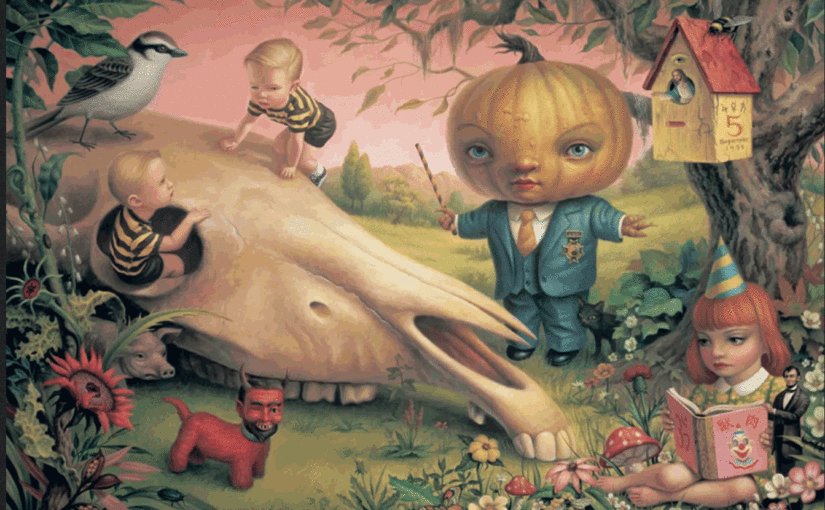Mark Ryden is an American artist based in California. He is said to have ushered in the new genre of painting and Pop Surrealism, into mainstream art culture. His style, which is reminiscent of the works of the Old Masters, has blurred the traditional boundaries between high and low art. Though inspired by surrealist techniques, he has filled his work with cultural connotations. His work is both mystical and realistic, innocent and eerie. The bright colors and childlike figures on the surface hide a darker, mysterious psyche. His paintings are meticulous and full of detail, with each detail having a significant importance.
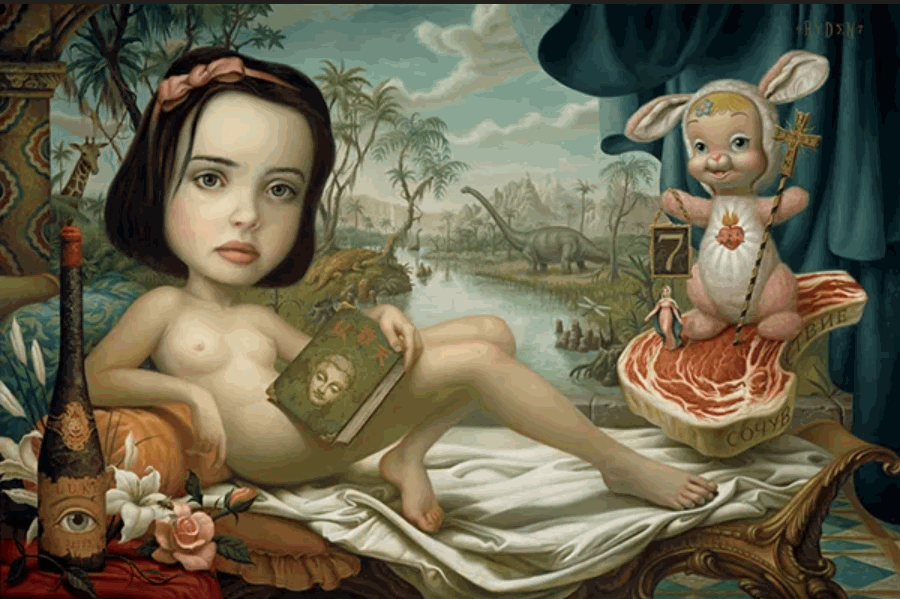
Mark Ryden. The painter Mark Ryden is one of the prominent representatives of the Lowbrow art movement, which is also called Surrealist Pop. - Mark Ryden - 42 artworks - WikiArt.org
Tell me a bit about yourself? How did you life in art begin? M.R.: I spent the vast majority of my time as a youth drawing and painting. I was also very interested in math and science, but art was my main love. In college, I pursued illustration because I didn’t see myself fitting it with what was happening in the fine art world of the 1980s. I had a passion for classical art, figuration, surrealism, and imagination. These subjects were all but banned from what I saw as a dry and dull art world at that time. For a decade I did commercial work, but things started to change dramatically in the 1990s. I found myself part of the fresh exciting art movement of Pop Surrealism.

Dressed in black with round, wire-rimmed glasses, a black fedora and a silvery goatee, the Pop Surrealist looks like a magical wizard as he surveys the fantastical haven of desserts he’s created for American Ballet Theatre’s new production of “Whipped Cream.”
It was quite the spectacle. It was his paintings brought to life.
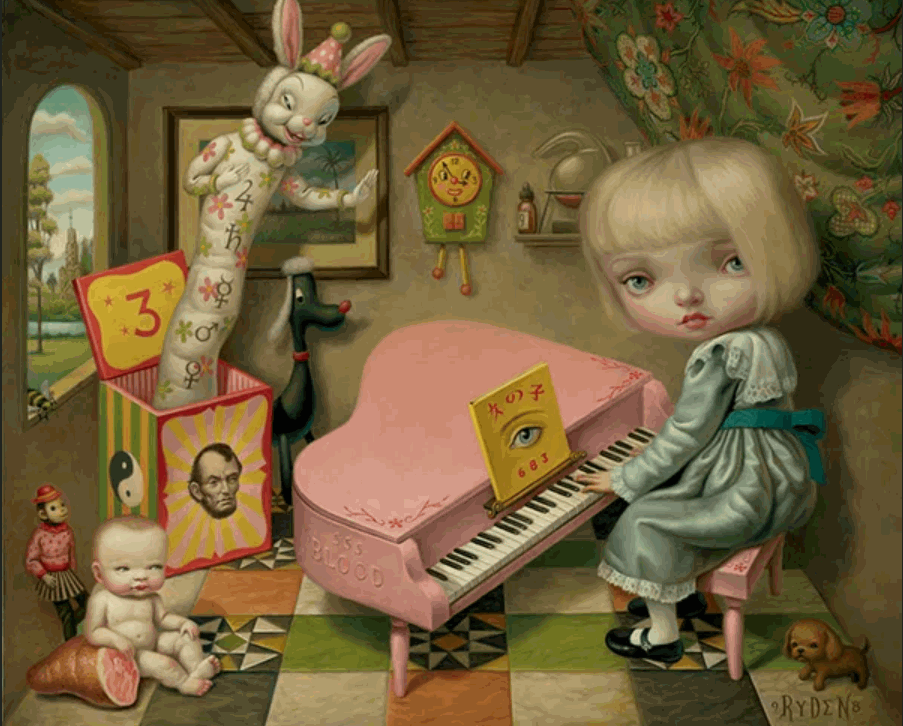
Ginormous sugary confections glint under draping stage lights: velvety swirls of sugar plum pastry, strawberry-topped cupcakes, powder-coated chocolate drops and glossy, melon-sized gum balls. Theatrical technicians, like Willy Wonka factory workers, scramble around the artist.
Stage hands roll towering peaks of whipped cream across the floor on dollies while prop artists affix Swarovski crystals to vanilla-iced tarts.
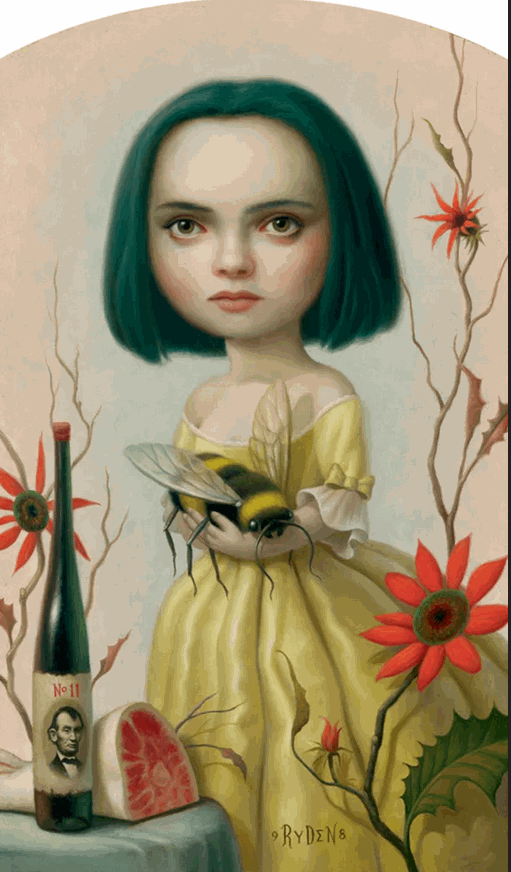
“C’mere,” Ryden beckons, slipping behind a cotton candy-pink dessert counter, a proverbial kid in his self-conjured candy store. The black backside of the giant set piece exposes the infrastructure behind the magic — ladders and trap doors that the dancers scurry up and through.
“It’s all these details,” Ryden says, showing off the underside of a monstrous tin coffee can that one of the characters pops out of. “We had to make these openings big enough for the dancers’ tutus to get through.”
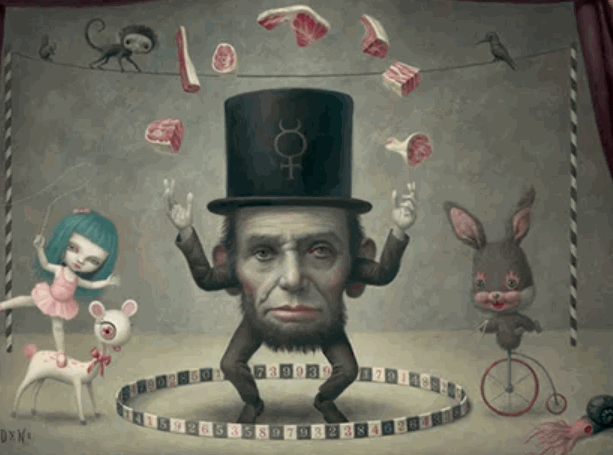
How did you develop your style or aesthetic? M.R.: I believe if an artist consciously attempts to develop a “style” that art will be hollow and superficial. An artist’s work has to develop more honestly and naturally. I think my work is simply the result of the subconscious accumulation of everything I am interested in. I try not to judge any particular inspiration as being more valid than another. I can let an Old Masters painting influence me just as much as a vintage cartoon.
Ryden, nicknamed the “godfather of Pop Surrealism” by Interview magazine, is known for his kitschy, brightly colored paintings blending pop culture elements and old master techniques for a glossy, danger-tinged, fairy-tale-like aesthetic. His first European retrospective, at the Centro de Arte Contemporáneo de Málaga in Spain, closed on March 5.

Can you describe your working process from idea to finished product? M.R.: I start by looking at the things I surround myself that inspire me. I can’t move forward in any way if I don’t feel a strong spark of excitement or creativity. It’s important to be in a peaceful state of mind and then I invite the spirits to come into the studio. I don’t stare into a blank canvas or paper. I look through my various collections of books, toys, statues, photographs and other things, and something will trigger an idea. I will make many, very loose sketches. Eventually I will be forced to pick something to take further. The decision is difficult because I can’t make that many finished paintings. They are meticulously painted and take a very long time to create.
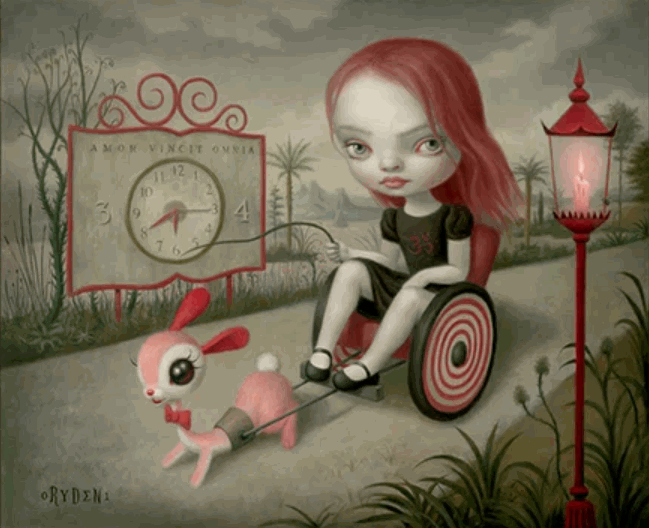
Ryden, who launched his career designing book and album covers, including Michael Jackson’s “Dangerous,” did more than simply design the costumes and backdrops though. His cutesy, seemingly saccharine style with a darkly humorous, Tim Burton-like twist inspired the creation of the production.
There’s something very unsettling, disturbing, about his paintings, which hides behind the sometimes very sweet surface.”
-Alexei Ratmansky

“His style is completely original, it’s very precise and detailed. He uses classical techniques, but the story he tells is very contemporary,” Ratmansky says. “There’s something very unsettling, disturbing, about his paintings, which hides behind the sometimes very sweet surface. I just thought it was a good fit for the music and that it would make this 1920s work feel contemporary.”
What are the various challenges you face? M.R.: My biggest challenge is managing my time. There are some many paintings and various projects that I want to do, but I can only do so many things. I often try to do too much. The business and logistical side of being an artist can swallow up all my time if I am not diligent to prevent it. I spend too much time with email. I hate email.
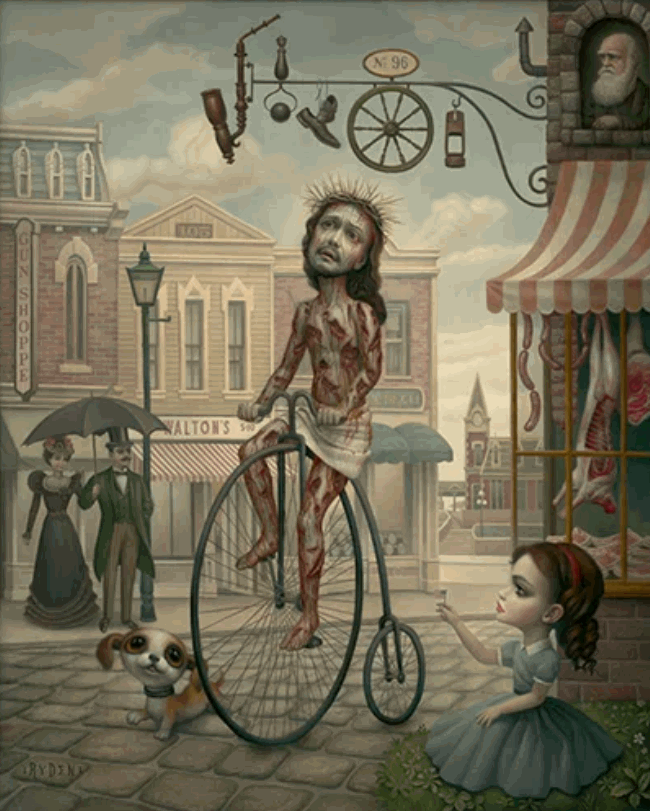
Ryden typically works solo, painting on flat canvases in his Portland, Ore., studio. He and his wife, the artist Marion Peck, moved there last year after Ryden had spent 35 years in L.A.
What kind of narratives or stories do you like to convey through your work? M.R.: I don’t attempt to convey any of my own stories or narratives, instead I like that my work can trigger the viewer to imagine their own narrative or story. For me, the meaning of a painting can’t be described with words or a story. Instead it is the image itself that is the meaning. I choose to work with figures that carry iconic power, but I like to leave the mystery undisturbed. I leave it to the viewer to interpret the images how they will.

Mark Ryden is a veteran of the Pop-Surrealism style, having been at the forefront of this genre since the late 1990’s when it was first taking roots in the artistic community. A curiosity cabinet personified, Mark Ryden’s works are often presented in thematic groups where one major theme is explored throughout the series, further interacting with Ryden’s main influences, including: Post world-war toys to historical figures such as Abraham Lincoln, meat, dogma, religion and symbolism, and into numerology, mysticism and occultism.
Ryden’s primary medium is oil on canvas or panel, with each piece beautifully and precisely encased in its own unique frame, many of which are original designs by Mark Ryden himself, with the remainder coming from restored antique frames. The frames are an artwork of and to themselves, and when married with the artwork, transports the viewer through the looking-glass and into a most surreal vision of the 19th century.

What would you cite as your inspirations behind your work? M.R.: Inspiration is the most valuable commodity for an artist; it is for me anyway. My studio is packed full of things that inspire me. I live inside my own cabinet of curiosities. My studio and house are overflowing with stuff. I regularly go to flea markets and antique shops where I have amassed a variety of things that inspire me. I collect everything from old children’s books, interesting product packages, to toys, photographs, medical models, skeletons, shells, minerals, and religious statues. I also have an extensive collection of books on shelves that go all the way up to the high ceiling behind my easel and drawing table. I think it is the range of diversity of my inspirations that most defines my art.
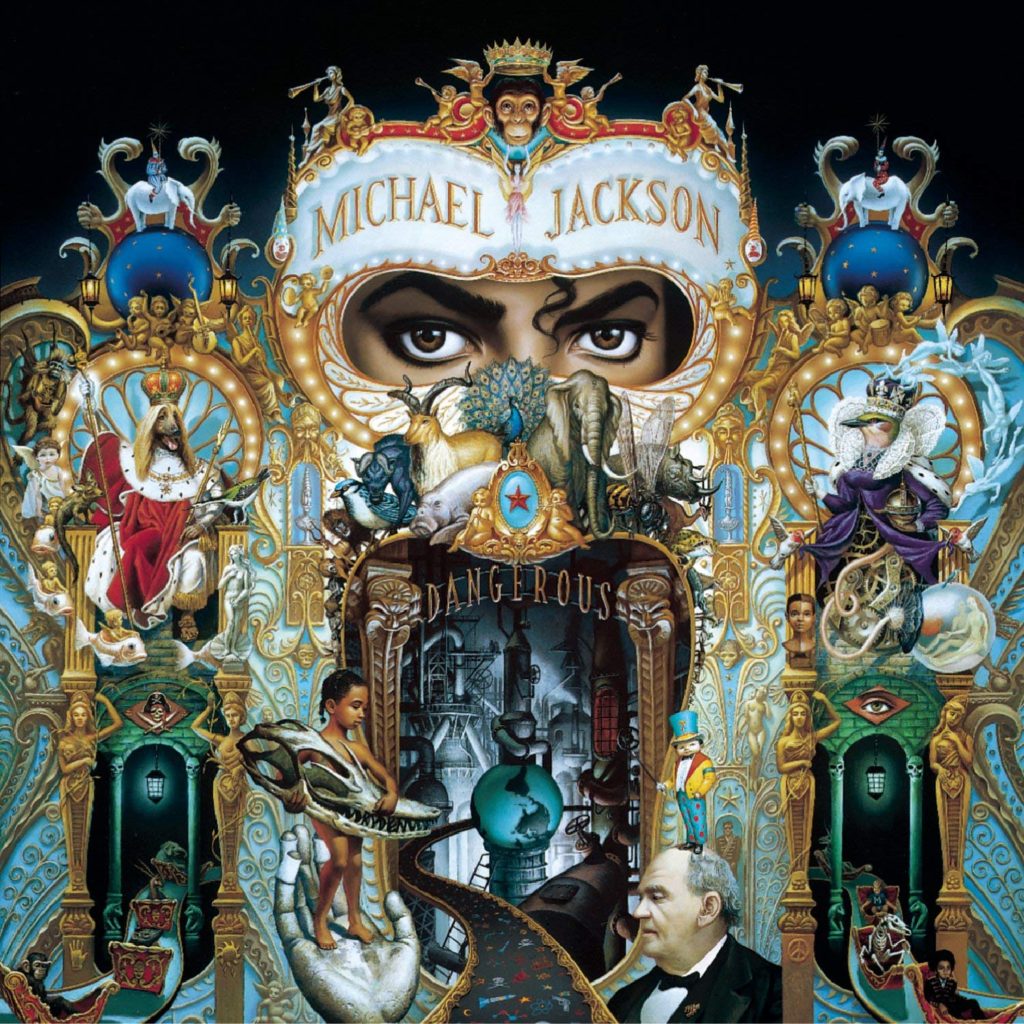
Artworks from Ryden’s 1998 “The Meat Show” series contemplate meat and the idea that we, stripped of our humanity, are ourselves meaty creations. Ryden also explores the relationship we have to meat as food, in comparison to the living creatures the meat was originally taken from, and also how the viewing of meat has changed over the centuries to a point where to see it depicted in contemporary artwork is almost absurd and strange. Such is our modern-day relationship with meat in much of western society.
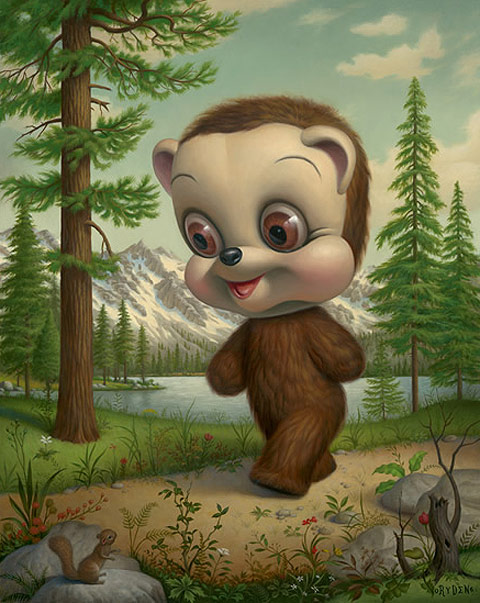
“I believe to get ideas you have to nourish the spirit. I stuff myself full of the things I like: pictures of bugs, paintings by Bouguereau and David, books about Pheneous T. Barnum, films by Ray Harryhausen, old photographs of strange people, children’s books about space and science, medical illustrations, music by Frank Sinatra and Debussy, magazines, T.V., Jung and Freud, Ren and Stimpy, Joseph Campbell and Nostradamus, Ken and Barbie, Alchemy, Freemasonary, Buddhism. At night my head is so full of ideas I can’t sleep. I mix it all together and create my own doctrine of life and the universe. To me, certain things seem to fit together. There are certain parallels and clues all over the place. There may be a little part of Alice in Wonderland that fits in. Charles Darwin, and Colonel Sanders provide pieces. To me the world is full of awe and wonder. This is what I put in my paintings.”
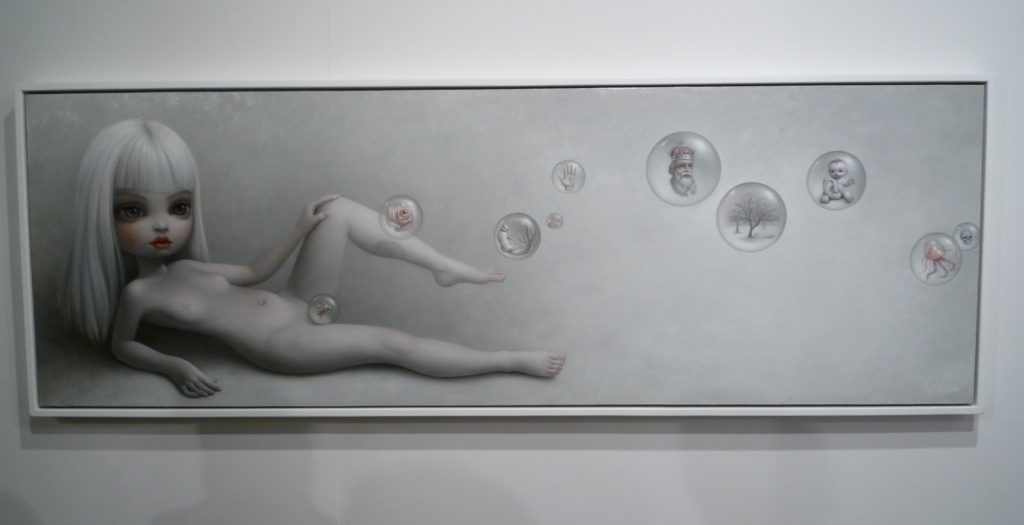
Which artists do you admire? How have they influenced you? M.R.: I admire and have been influenced by countless artists. Most are from long ago such as Carpaccio and Bronzino from the early Italian Renaissance. I like Northern Dutch artists like Van Eyck and the later French academic painters David, Gérôme and Ingres. But, I also like contemporary artists like John Currin. One of my favorite painters right now is Neo Rauch. They all influence me in many different ways. I like the way Bouguereau exquisitely paints flesh while the characters of Leonoroa Carrington seem mystical.
Ryden is also a proficient writer and includes artist statements and review essays for each of his artistic series, which can be found at his website here. Reading through the writings, one is immediately drawn to the open frankness Ryden has when discussing his method, as described in his statement for “Wondertoonel” 2004, (which roughly translates as “wondrous theatre”) which gives the viewer an insight into the mind of the artist whilst also providing a guide to navigate his breathtakingly surreal artworks by:
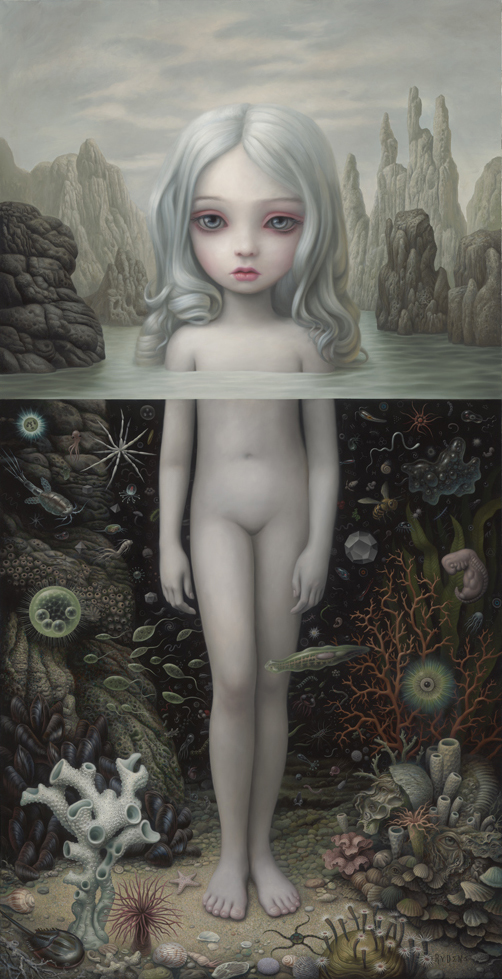
“It is only in childhood that contemporary society truly allows for imagination. Children can see a world ensouled, where bunnies weep and bees have secrets, where “inanimate” objects are alive. Many people think that childhood’s world of imagination is silly, unworthy of serious consideration, something to be outgrown. Modern thinking demands that an imaginative connection to nature needs to be overcome by “mature” ways of thinking about the world. Human beings used to connect to life through mystery and mythology. Now this kind of thinking is regarded as primitive or naive. Without it, we cut ourselves off from the life force, the world soul, and we are empty and starving.”
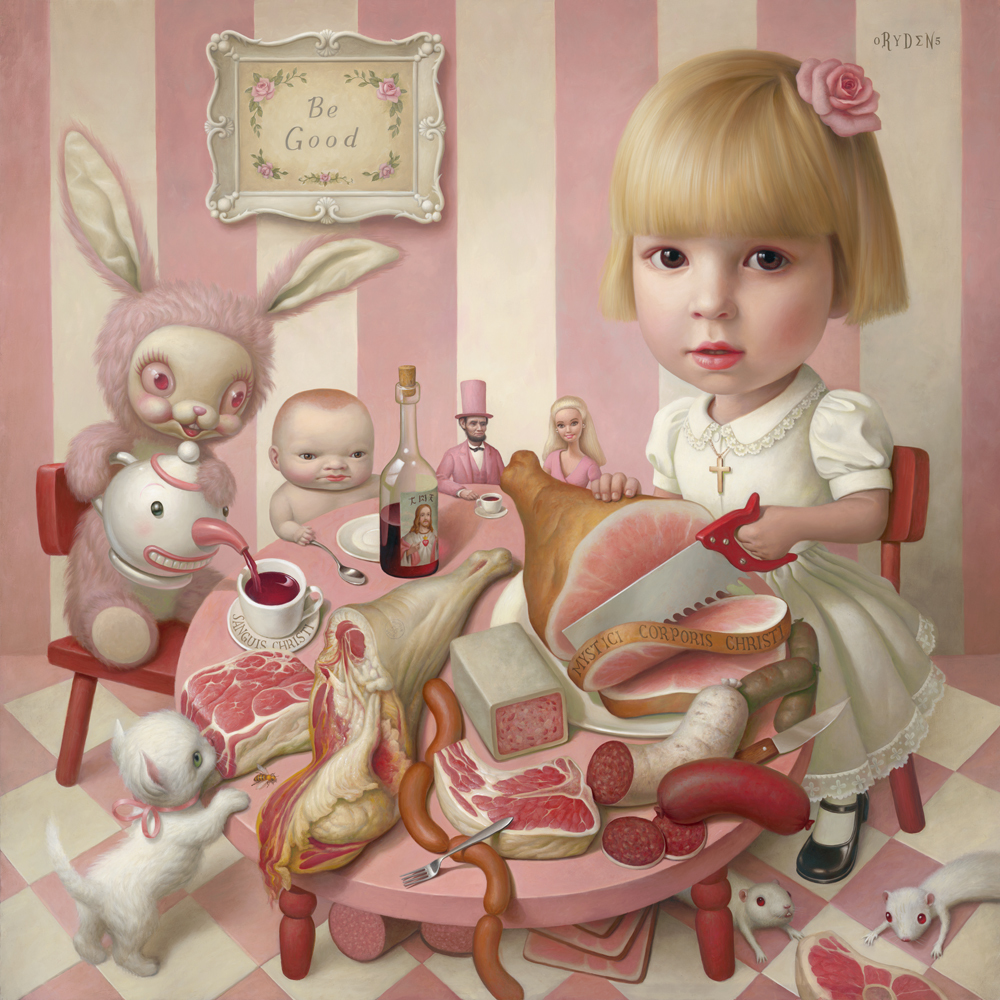
What would you say is your favorite piece of your own work and what does it mean to you? M.R.: I like different pieces for different reasons. One piece that pops into mind is Medium Yams because of its modest scale and simplicity. In general I gravitate towards creating massive, detailed, and epic works. While Medium Yams was a very small and simple piece it held great power. It was a favorite of many at the exhibition where it was displayed.
- Mark Ryden – Wikipedia
- Mark Ryden – 42 artworks – WikiArt.org
- Mark Ryden – 45 Artworks, Bio & Shows on Artsy
- Biography of Mark Ryden | Widewalls
- Mark Ryden | artnet
- Mark Ryden – Home | Facebook
- Amazon.com: mark ryden prints
Mark Ryden came to preeminence in the 1990’s during a time when many artists, critics and collectors were quietly championing a return to the art of painting. With his masterful technique and disquieting content, Ryden quickly became one of the leaders of this movement on the West Coast.
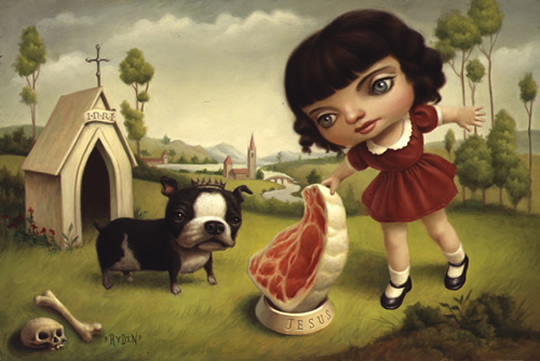
Upon first glance Ryden’s work seems to mirror the Surrealists’ fascination with the subconscious and collective memories. However, Ryden transcends the initial Surrealists’ strategies by consciously choosing subject matter loaded with cultural connotation. His dewy vixens, cuddly plush pets, alchemical symbols, religious emblems, primordial landscapes and slabs of meat challenge his audience not necessarily with their own oddity but with the introduction of their soothing cultural familiarity into unsettling circumstances.
Viewers are initially drawn in by the comforting beauty of Ryden’s pop-culture references, then challenged by their circumstances, and finally transported to the artist’s final intent – a world where creatures speak from a place of childlike honesty about the state of mankind and our relationships with ourselves, each other and our past.

There is an obvious horror connected with the meat industry. The blood, the gore, the inhumane butchery. So many of us indirectly participate in this with our ravenous consumption of meat. Sue Coe has explored that arena exquisitely in her work and writings. In my own art I am not personally making a statement or judgement about the meat consumption in our culture. I feel more like I am just observing it. Just like T-rex, I myself am a passionate meat-eater. I feel that the consumption of animal flesh is a natural primal instinct just like sex and making paintings. But there is that paradox of knowing how that scrumptious porterhouse made it to my dinner plate. We have lost any kind of reverence for this. It would be interesting if people would have to kill an animal themselves before they earned the right to eat it. Beyond the conceptual impact, meat simply has a very strong visual quality. The wonderful variety of textures and patterns in the marbling of the meat is sumptuous. Subtle pinks gently swirl around with rich vermillions and fatty yellow ochres. These visual qualities alone are seductive enough to make meat the subject of a work of art. Meat is glorious to paint. It is so easy to transcend the representational to the abstract. Meat has been a subject for painters from Rembrandt to Van Gogh. - In a quote from Juxtapoz magazine back in the day, Ryden explains his reason for incorporation meat into his work.
Clearly infused with classical references, Ryden’s work is not only inspired by recent history, but also the works of past masters. He counts among his influences Bosch, Bruegel and Ingres with generous nods to Bouguereau and Italian and Spanish religious painting.
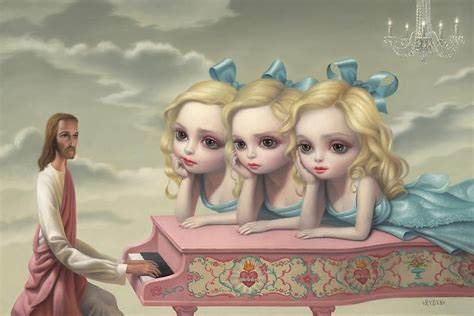
Over the past decade, this marriage of accessibility, craftsmanship and technique with social relevance, emotional resonance and cultural reference has catapulted Ryden beyond his roots and to the attention of museums, critics and serious collectors. Ryden’s work has been exhibited in museums and galleries worldwide, including a recent museum retrospective “Wondertoonel” at the Frye Museum of Art in Seattle and Pasadena Museum of California Art.
Mark Ryden was born in Medford Oregon. He received a BFA in 1987 from Art Center College of Design in Pasadena. He currently lives and works in Los Angeles where he paints slowly and happily amidst his countless collections of trinkets, statues, skeletons, books, paintings and antique toys.
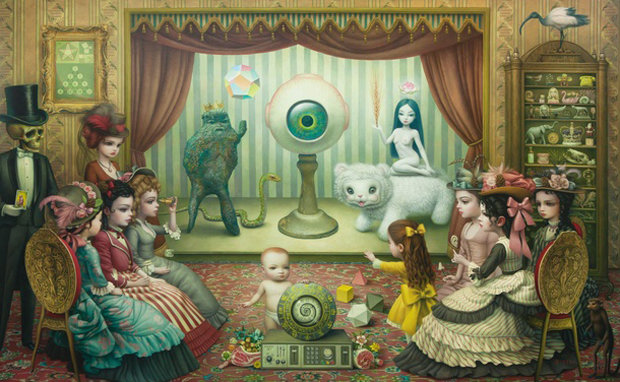
To see more of Mark Ryden’s stunning artwork, please visit his website, or his Facebook page.
Movies that Inspired Me
Here are some movies that I consider noteworthy and worth a view. Enjoy.




Stories that Inspired Me
Here are reprints in full text of stories that inspired me, but that are nearly impossible to find in China. I place them here as sort of a personal library that I can use for inspiration. The reader is welcome to come and enjoy a read or two as well.









































My Poetry

Art that Moves Me





Articles & Links
You’ll not find any big banners or popups here talking about cookies and privacy notices. There are no ads on this site (aside from the hosting ads – a necessary evil). Functionally and fundamentally, I just don’t make money off of this blog. It is NOT monetized. Finally, I don’t track you because I just don’t care to.
- You can start reading the articles by going HERE.
- You can visit the Index Page HERE to explore by article subject.
- You can also ask the author some questions. You can go HERE to find out how to go about this.
- You can find out more about the author HERE.
- If you have concerns or complaints, you can go HERE.
- If you want to make a donation, you can go HERE.

